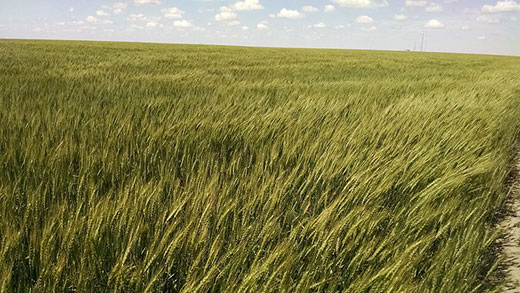
Kansas State University and the University of Saskatchewan in Canada will be working together to improve the productivity and nutrition of wheat. (File photo)
K-State teams with Canadian university to apply gene editing technology for improving wheat
Groups will cooperate on $650K grant from National Institute of Food and Agriculture
August 10, 2020
MANHATTAN, Kan. – Kansas State University officials say a $650,000 grant from the USDA”s National Institute of Food and Agriculture has spurred a partnership with a Canadian university to improve wheat using genome editing technology.
Eduard Akhunov, a wheat geneticist who will lead K-State’s work on this project in collaboration with colleague Harold Trick's research team, said the university will join with researchers at the University of Saskatchewan in using genome editing technology to improve productivity and nutrition in the world’s wheat lines.
Genome editing, he said, relies on a technology called clustered regularly interspaced short palindromic repeats – better known by its abbreviation, CRISPR.
“CRISPR is a powerful and extremely precise molecular tool capable of making targeted changes in genetic code,” Akhunov said. “It allows us to produce novel variants of genes that have improved properties and create a positive impact on the traits of interest.”
Using genome editing to target genes that are linked to valuable agronomic traits allows researchers to accelerate the development of crops that produce higher yields, are more nutritious or yield higher quality grain.
“Our project will use the capabilities of CRISPR-Cas (referring to use of the technology with an associated protein) to empower traditional breeding strategies,” Akhunov said. “Integrating this tool into modern breeding practices can substantially speed up the rate of genetic gain by accelerating the identification of agronomic genes, broadening genetic diversity, and reducing the time required for traits introgression (transfer) into the adapted germplasm.”
Curtis Pozniak, director of the Crop Development Centre at the University of Saskatchewan, leads his university’s work. Together, the research groups will use CRISPR to introduce domesticated traits into wild wheat relatives. “These efforts may pave new ways for broadening the genetic diversity of modern bread wheat by creating newly domesticated varieties of wild crops,” Akhunov said.
“Our combined efforts should help to establish the CRISPR-Cas technology as a precision breeding tool in the wheat breeder’s toolbox for characterizing, developing and transferring traits into their breeding programs.”
Akhunov’s research team at K-State has previously used CRISPR-based genome editing to create novel variants of genes and develop wheat lines with increased grain size and weight, and number of grains per head.
He said the new project also will test a new strategy to create novel trait variation by mutating a region of the wheat genome that is responsible for regulating genes tied to nitrogen uptake, carbon fixation, growth and nutrient remobilization.
“Currently, there is limited understanding of the range of possible variation for these traits that can be generated by editing these regulatory regions of genes,” Akhunov said.
The project will collaborate closely with NIFA’s Wheat Coordinated Agriculture Project (Wheat-CAP), a multi-state project; the International Wheat Yield Partnership; and the NIFA IWYP Winter Wheat Breeding Innovation Hub, which was recently established at K-State.

